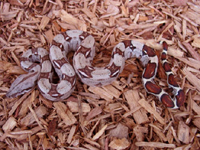

 |

|
 Boa Constrictor |
Boa Constrictor(Reptile) |
 Boa Constrictor Baby |
Boa Constrictor HabitsThe boa constrictor's preferred habitat is rainforest, but it it also found in semiarid savannah. Because its range covers such a large area, the boa constrictor varies considerably in color, marking, and size. On Hog Island, off Central America, the boa constrictor is seldom longer than 3 feet; in most of Central America, it reaches 10 feet, while in Trinidad and Venezuela, it can grow to 20 feet.
In the warmer areas, the boa constrictor is active throughout the year. However, in the cooler climes, it may spend long periods of time inactive.
Man is the adult boa constrictor's only enemy. However, young boa constrictors are preyed upon by a large variety of forest-dwelling animals such as coatis, hawks, caimans, and wild pigs.
In many parts of its range, the boa constrictor is considered a pest and is killed by farmers because it kills their chickens. It is believed that the snake kills other types of livestock as well.
Boa constrictors are also hunted for their skins, which are sold at high prices. They are killed for food, adn also simply out of fear of them. |
Boa Constrictor CommunicationSnakes rely mainly on visual and chemosensory cues to communicate and to survive. Nocturnal snakes like the Boa constrictor posses vertical pupils which give boas their great sense of sight. Besides visual senses the macajuel uses chemical sense more often since, chemicals remain even after animal has left. Main chemical sensory organs are the olfactory and vomeronasal systems. The nasal cavity has ciliated epithelia that are very sensitive to volatile odours which enable the animal to pick up scents very readily. Another organ that helps increase boas senses is the Jacobsons organ, which consists of a pit lined with sensory epithelia located on the roof of the snakes mouth.
There are other organs that help in receiving stimulus, one such organ is the tongue, it helps by gathering chemicals and guiding it to the ducts inside the mouth of the snake. Tongue flick patterns change in different situations. Chemical communication is very important in boa constrictors. They produce pheromone which can create a change in behaviour of other boas or other species. The site of production is the epidermal lipid gland. Other glands also release pheromones such as the cloaca, which emits chemical during courtship and shedding periods. |
Boa Constrictor BreedingThe boa constrictor has appendages resembling claws on each side of its vent (genital opening). They are the remnants, or vestiges, of the hind limbs inherited form the boa\s lizard-like ancestors. The appendages are generally larger in males than females and are thought to be used by the male to stimulate the female to mate.
After fertilization, the eggs remain in the female's body, where they develop over several months inside thin membranes. Unlike its close relative, the python, the boa constrictor gives birth to live fully formed young. The protective membranes rupture as the young are released. As many as sixty snakes are born at one time, each measuring 17-20 inches.
The young boa constrictor begins feeding within a week or two after its birth and grows quickly, usually reaching a yard in length after several months. It is sexually mature at 2-3 years when it reaches 6-10 feet. |
Boa Constrictor Food & FeedingThe boa constrictor eats a wide variety of food. Young snakes eat mice, small birds, lizards, and frogs. As the snake grows, the size of its prey increases. Adults will eat monkeys, capybaras, agoutis, caimans, and wild pigs.
The boa is a good swimmer and spends a lot of time near and in rivers. It waits for any prey which may come near the water to drink. Once a victim has been overpowered, it is swallowed whole.
Since the boa is cold-blooded and slow moving, it does not require a great amount of food. After eating large prey, such as a wild pig, the snake will not eat for a week or more. |
Boa Constrictor Key Facts |
| Size |
| Height: Length: 3-20 feet |
| Weight: 60 pounds |
| Breeding |
| Sexual maturity: 2-3 years old |
| Mating: Between April and August |
| Gestation: 6 months |
| Number of young: 20-60 born alive |
| Lifestyle |
| Habit: Solitary, except during breeding season |
| Diet: Almost any mammal or bird small enough to be swallowed |
| Lifespan: 20-30 years |
DID YOU KNOW?
|
CAN'T FIND WHAT YOU'RE LOOKING FOR? CLICK HERE!!!